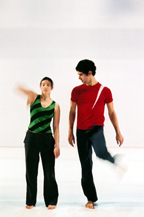Dutch Delight
by John Percival
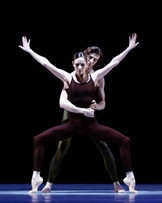 After too long a gap, the Dutch National Ballet arrived back in London with a great programme and great dancing: so enjoyable that I had to rush back for a second sitting. Let me say at once that they received some very sniffy reviews in the national papers — which to my mind tells more about the standards of criticism nowadays than it does about what was on offer. Audience response was very warm and word-of-mouth praise later brought in good houses. I was set thinking about how much we used to see of the two major Dutch companies — how often, even, I was able to pop over to Amsterdam or The Hague to catch them — and also how much their example influenced British ballet by bringing about the transformation of Ballet Rambert and thereafter a whole wave of contemporary troupes. Not bad for a small country that had little ballet until after World. READ MORE
After too long a gap, the Dutch National Ballet arrived back in London with a great programme and great dancing: so enjoyable that I had to rush back for a second sitting. Let me say at once that they received some very sniffy reviews in the national papers — which to my mind tells more about the standards of criticism nowadays than it does about what was on offer. Audience response was very warm and word-of-mouth praise later brought in good houses. I was set thinking about how much we used to see of the two major Dutch companies — how often, even, I was able to pop over to Amsterdam or The Hague to catch them — and also how much their example influenced British ballet by bringing about the transformation of Ballet Rambert and thereafter a whole wave of contemporary troupes. Not bad for a small country that had little ballet until after World. READ MORE
Three reports on
Beyond the Waltz: Austrodance Festival 2006:
by Naima Prevots
Willie Dorner - Compelling clarity and wit
Dana Tai-Soon Burgess - Honoring Mozart and exploring memory
and last week's report on the Festival by Rita Felciano
Doug Varone's 20th Anniversary Program
by Susan Reiter
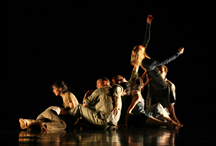 Among the many deeply satisfying aspects of Doug Varone’s 20th-anniversary program of three works was the welcome, and increasingly rare, true craftsmanship on display. Varone’s musical instincts and spatial awareness were unfailingly on the mark, but there was another element at play — something instinctual, presumably inborn rather than learned, that imbues his dances with an organic shape and inner motor as well as profound logic. Using just eight dancers, and smartly elegant design elements, he offered works that seized the viewer with quietly insistent intensity, and resonated well beyond the two hours in the theater. READ MORE
Among the many deeply satisfying aspects of Doug Varone’s 20th-anniversary program of three works was the welcome, and increasingly rare, true craftsmanship on display. Varone’s musical instincts and spatial awareness were unfailingly on the mark, but there was another element at play — something instinctual, presumably inborn rather than learned, that imbues his dances with an organic shape and inner motor as well as profound logic. Using just eight dancers, and smartly elegant design elements, he offered works that seized the viewer with quietly insistent intensity, and resonated well beyond the two hours in the theater. READ MORE
Left-wing Christians
by Paul Parish
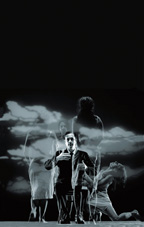 In twenty years, Joe Goode has gone from being the Bay Area's foremost dance theater subversive — the gay iconoclast — through obsession with AIDS, to being established as the most honest choreographer/poet of relationship in our anxious era. He's always worked your nerves: the uneasiness used to be in the seductiveness, now it's in how to be sure you've found what you're looking for. All along the way, he's been developing themes of longing; he used to use pop imagery (Doris Day and Rock Hudson, the power of ad-men to stimulate desire — "Eternity, Infiniti, Lexus") to dramatize a hysterical ambivalence about swallowing the tempting bait. READ MORE
In twenty years, Joe Goode has gone from being the Bay Area's foremost dance theater subversive — the gay iconoclast — through obsession with AIDS, to being established as the most honest choreographer/poet of relationship in our anxious era. He's always worked your nerves: the uneasiness used to be in the seductiveness, now it's in how to be sure you've found what you're looking for. All along the way, he's been developing themes of longing; he used to use pop imagery (Doris Day and Rock Hudson, the power of ad-men to stimulate desire — "Eternity, Infiniti, Lexus") to dramatize a hysterical ambivalence about swallowing the tempting bait. READ MORE
Images of Isadora
by George Jackson
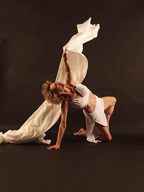 Nowhere is it more difficult to tell dance from dancer than in the solo, particularly the modern dance solo with its free movement vocabulary. The two women who portrayed Isadora Duncan on this program are quite distinct in terms of body and buoyancy. Cynthia Word is tall, angular and light boned whereas Jeanne Bresciani is rounded, firm and forceful. What they share is intensity and meticulous attention to detail, and these abilities made it possible for them to do more than execute choreography “by” or “after” Duncan. They impersonated (in the best sense) the artist that was Isadora. READ MORE
Nowhere is it more difficult to tell dance from dancer than in the solo, particularly the modern dance solo with its free movement vocabulary. The two women who portrayed Isadora Duncan on this program are quite distinct in terms of body and buoyancy. Cynthia Word is tall, angular and light boned whereas Jeanne Bresciani is rounded, firm and forceful. What they share is intensity and meticulous attention to detail, and these abilities made it possible for them to do more than execute choreography “by” or “after” Duncan. They impersonated (in the best sense) the artist that was Isadora. READ MORE
Mosaic of survival
by Leigh Witchel
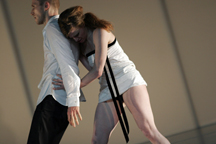 “How did I live through that?” It’s amazing what humans can endure. We pull into ourselves and concentrate on immediate tasks, minimal goals, just getting through the next minute, hour, or day. Meanwhile, the electricity is on only four hours a day, meat is being rationed or another block is being closed off and the buildings bricked up. Sometimes we don’t know how hostile a situation is until we escape it; only when we’re finally free does it really hit us what we had to live through. Roseanne Spradlin’s “Survive Cycle” primarily concerned itself with a more personal kind of survival, but was most eloquent at its most universal. READ MORE
“How did I live through that?” It’s amazing what humans can endure. We pull into ourselves and concentrate on immediate tasks, minimal goals, just getting through the next minute, hour, or day. Meanwhile, the electricity is on only four hours a day, meat is being rationed or another block is being closed off and the buildings bricked up. Sometimes we don’t know how hostile a situation is until we escape it; only when we’re finally free does it really hit us what we had to live through. Roseanne Spradlin’s “Survive Cycle” primarily concerned itself with a more personal kind of survival, but was most eloquent at its most universal. READ MORE
Transitions
by Susan Reiter
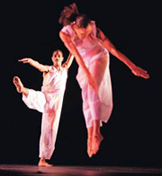 “Prelude (‘Discipline is Freedom’)” has been the traditional program opener for Garth Fagan Dance for many years. For its most recent Joyce Theater season, the company planned to perform it on the second of its two programs, but not the first. But an injury necessitated some program shifting, so the opening night curtain rose on “Prelude,” with its initially silent, meditative sequence of bodies carving through space or moving quietly in place — the elements of a warm-up, but elevated to a higher plane. READ MORE
“Prelude (‘Discipline is Freedom’)” has been the traditional program opener for Garth Fagan Dance for many years. For its most recent Joyce Theater season, the company planned to perform it on the second of its two programs, but not the first. But an injury necessitated some program shifting, so the opening night curtain rose on “Prelude,” with its initially silent, meditative sequence of bodies carving through space or moving quietly in place — the elements of a warm-up, but elevated to a higher plane. READ MORE
